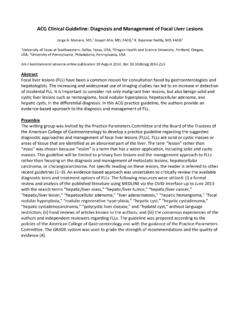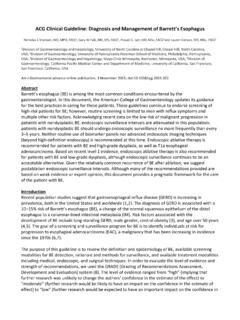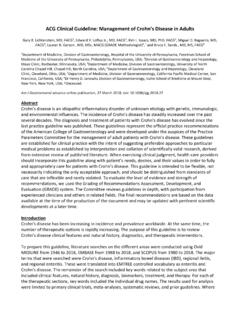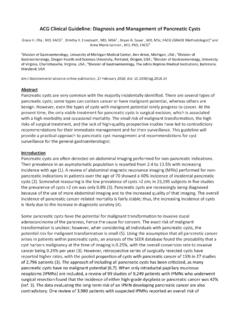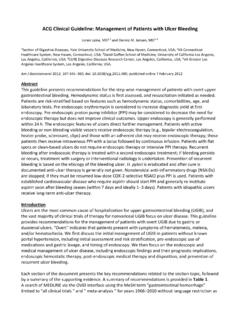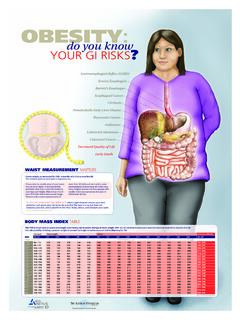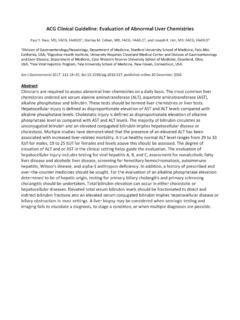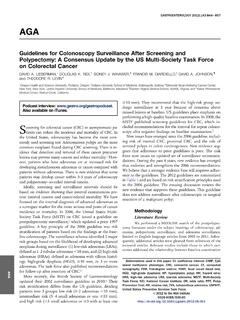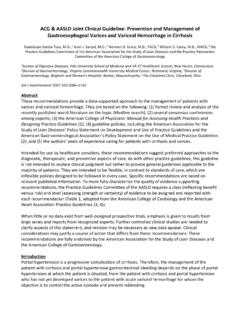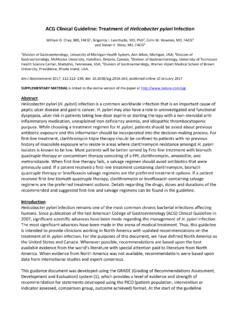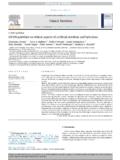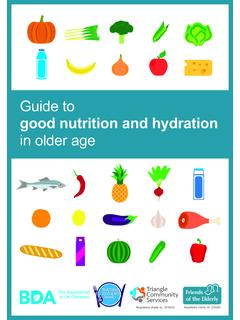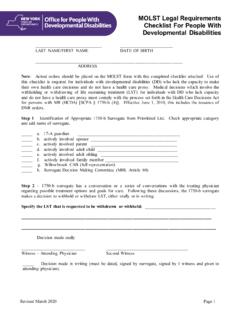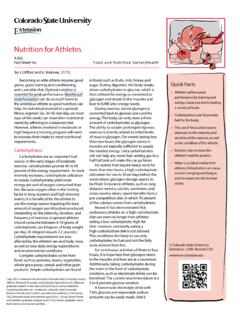Transcription of ACG Clinical Guideline: Management of Acute Pancreatitis
1 ACG Clinical Guideline: Management of Acute Pancreatitis Scott Tenner, MD, MPH, FACG1, John Baillie, MB, ChB, FRCP, FACG2, John DeWitt, MD, FACG3 and Santhi Swaroop Vege, MD, FACG4 1 State University of New York, Downstate Medical Center, Brooklyn, New York, USA; 2 Carteret MedicalGroup, Morehead City, North Carolina, USA; 3 Indiana University Medical Center, Indianapolis, Indiana, USA; 4 Mayo Clinic, Rochester, Minnesota, USA. Am J Gastroenterol 2013; 108:1400 1415; ; published online 30 July 2013 Abstract This guideline presents recommendations for the Management of patients with Acute Pancreatitis (AP). During the past decade, there have been new understandings and developments in the diagnosis, etiology, and early and late Management of the disease. As the diagnosis of AP is most often established by Clinical symptoms and laboratory testing, contrast-enhanced computed tomography (CECT) and/or magnetic resonance imaging (MRI) of the pancreas should be reserved for patients in whom the diagnosis is unclear or who fail to improve clinically.
2 Hemodynamic status should be assessed immediately upon presentation and resuscitative measures begun as needed. Patients with organ failure and/or the systemic inflammatory response syndrome (SIRS) should be admitted to an intensive care unit or intermediary care setting whenever possible. Aggressive hydration should be provided to all patients, unless cardiovascular and/or renal comorbidites preclude it. Early aggressive intravenous hydration is most beneficial within the first 12 24 h, and may have little benefit beyond. Patients with AP and concurrent Acute cholangitis should undergo endoscopic retrograde cholangiopancreatography (ERCP) within 24 h of admission. Pancreatic duct stents and/or postprocedure rectal nonsteroidal anti-inflammatory drug (NSAID) suppositories should be utilized to lower the risk of severe post-ERCP Pancreatitis in high-risk patients.
3 Routine use of prophylactic antibiotics in patients with severe AP and/or sterile necrosis is not recommended. In patients with infected necrosis, antibiotics known to penetrate pancreatic necrosis may be useful in delaying intervention, thus decreasing morbidity and mortality. In mild AP, oral feedings can be started immediately if there is no nausea and vomiting. In severe AP, enteral nutrition is recommended to prevent infectious complications, whereas parenteral nutrition should be avoided. Asymptomatic pancreatic and/or extrapancreatic necrosis and/or pseudocysts do not warrant intervention regardless of size, location, and/or extension. In stable patients with infected necrosis, surgical, radiologic, and/or endoscopic drainage should be delayed, preferably for 4 weeks, to allow the development of a wall around the necrosis. Introduction Acute Pancreatitis (AP) is one of the most common diseases of the gastrointestinal tract, leading to tremendous emotional, physical, and financial human burden (1,2).
4 In the United States, in 2009, AP was the most common gastroenterology discharge diagnosis with a cost of billion dollars (2). Recent studies show the incidence of AP varies between and cases per 100,000 worldwide (3,4). An increase in the annual incidence for AP has been observed in most recent studies. Epidemiologic review data from the 1988 to 2003 National Hospital Discharge Survey showed that hospital admissions for AP increased from 40 per 100,000 in 1998 to 70 per 100,000 in 2002. Although the case fatality rate for AP has decreased over time, the overall population mortality rate for AP has remained unchanged (1). There have been important changes in the definitions and classification of AP since the Atlanta classification from 1992 (5). During the past decade, several limitations have been recognized that led to a working group and web-based consensus revision (6).
5 Two distinct phases of AP have now been identified: (i) early (within 1 week), characterized by the systemic inflammatory response syndrome (SIRS) and/or organ failure; and (ii) late (>1 week), characterized by local complications. It is critical to recognize the paramount importance of organ failure in determining disease severity. Local complications are defined as peripancreatic fluid collections, pancreatic and peripancreatic necrosis (sterile or infected), pseudocysts, and walled-off necrosis (sterile or infected). Isolated extrapancreatic necrosis is also included under the term necrotizing Pancreatitis ; although outcomes like persistent organ failure, infected necrosis, and mortality of this entity are more often seen when compared to interstitial Pancreatitis , these complications are more commonly seen in patients with pancreatic parenchymal necrosis (7).
6 There is now a third intermediate grade of severity, moderately severe AP, that is characterized by local complications in the absence of persistent organ failure. Patients with moderately severe AP may have transient organ failure, lasting <48 h. Moderately severe AP may also exacerbate underlying comorbid disease but is associated with a low mortality. Severe AP is now defined entirely on the presence of persistent organ failure (defined by a modified Marshall Score) (8). We first discuss the diagnosis, etiology, and severity of AP. We then focus on the early medical Management of AP followed by a discussion of the Management of complicated disease, most notably pancreatic necrosis. Early Management focuses on advancements in our understanding of aggressive intravenous hydration , which when applied early appears to decrease morbidity and mortality (9,10).
7 The evolving issues of antibiotics, nutrition , and endoscopic, radiologic, surgical, and other minimally invasive interventions will be addressed. A search of MEDLINE via the OVID interface using the MeSH term Acute Pancreatitis limited to Clinical trials, reviews, guidelines , and meta-analysis for the years 1966 2012 was undertaken without language restriction, as well as a review of Clinical trials and reviews known to the authors were performed for the preparation of this document. The GRADE system was used to grade the strength of recommendations and the quality of evidence (11). An explanation of the quality of evidence and strength of the recommendations is shown in Table 1. Each section of the document presents the key recommendations related to the section topic, followed by a summary of the supporting evidence. A summary of recommendations is provided in Table 2.
8 Table 1. GRADE system of quality of evidence and strength of recommendation High Further research is very unlikely to change our confidence in the estimate of effect. Moderate Further research is likely to have an important impact on our confidence in the estimate of effect and may change the estimate. Low Further research is very likely to have an important impact on our confidence in the estimate of effect and is likely to change the estimate. Very Low Any estimate of the effect is very uncertain. Table 2. Summary of recommendations Diagnosis 1. The diagnosis of AP is most often established by the presence of two of the three following criteria: (i) abdominal pain consistent with the disease, (ii) serum amylase and/or lipase greater than three times the upper limit of normal, and/or (iii) characteristic findings from abdominal imaging (strong recommendation, moderate quality of evidence).
9 2. Contrast-enhanced computed tomographic (CECT) and/or magnetic resonance imaging (MRI) of the pancreas should be reserved for patients in whom the diagnosis is unclear or who fail to improve clinically within the first 48 72 h after hospital admission (strong recommendation, low quality of evidence). Etiology 3. Transabdominal ultrasound should be performed in all patients with Acute Pancreatitis (strong recommendation, low quality of evidence). 4. In the absence of gallstones and/or history of significant history of alcohol use, a serum triglyceride should be obtained and considered the etiology if >1,000 mg/dl (conditional recommendation, moderate quality of evidence). 5. In a patient older than 40 years, a pancreatic tumor should be considered as a possible cause of Acute Pancreatitis (conditional recommendation, low quality of evidence). 6. Endoscopic investigation in patients with Acute idiopathic Pancreatitis should be limited, as the risks and benefits of investigation in these patients are unclear (conditional recommendation, low quality of evidence).
10 7. Patients with idiopathic Pancreatitis should be referred to centers of expertise (conditional recommendation, low quality of evidence). 8. Genetic testing may be considered in young patients (<30 years old) if no cause is evident and a family history of pancreatic disease is present (conditional recommendation, low quality of evidence). Initial assessment and risk stratification 9. Hemodynamic status should be assessed immediately upon presentation and resuscitative measures begun as needed (strong recommendation, moderate quality of evidence). 10. Risk assessment should be performed to stratify patients into higher- and lower-risk categories to assist triage, such as admission to an intensive care setting (conditional recommendation, moderate quality of evidence). 11. Patients with organ failure should be admitted to an intensive care unit or intermediary care setting whenever possible (strong recommendation, low quality of evidence).
